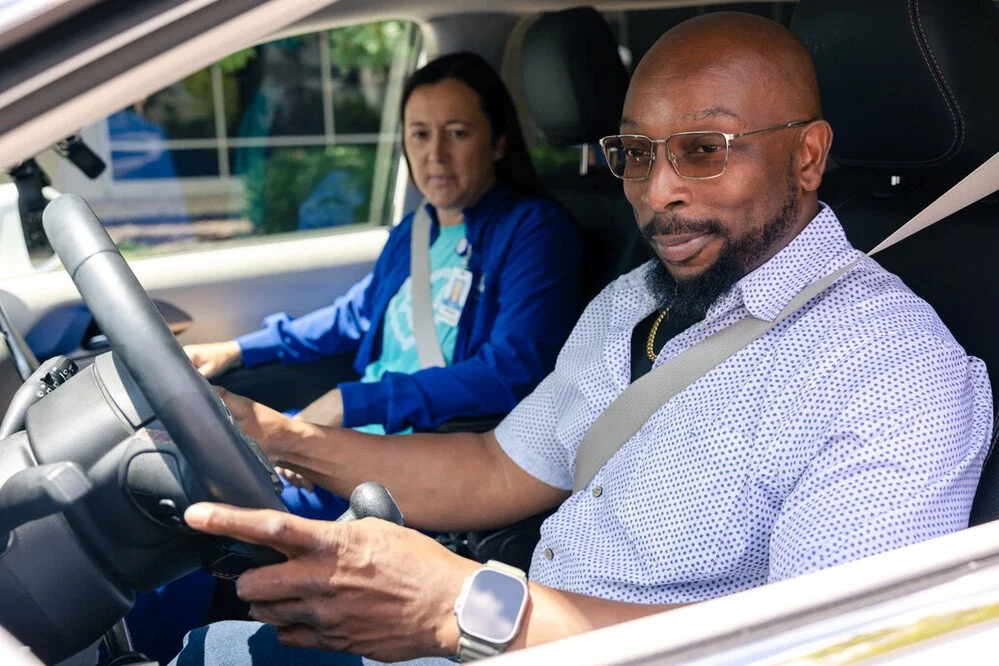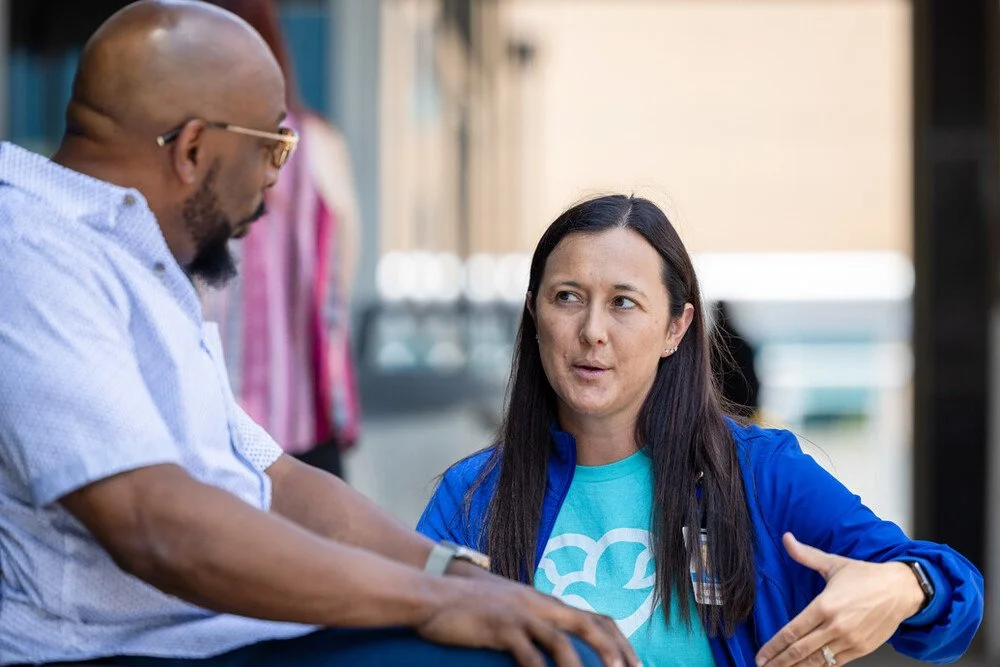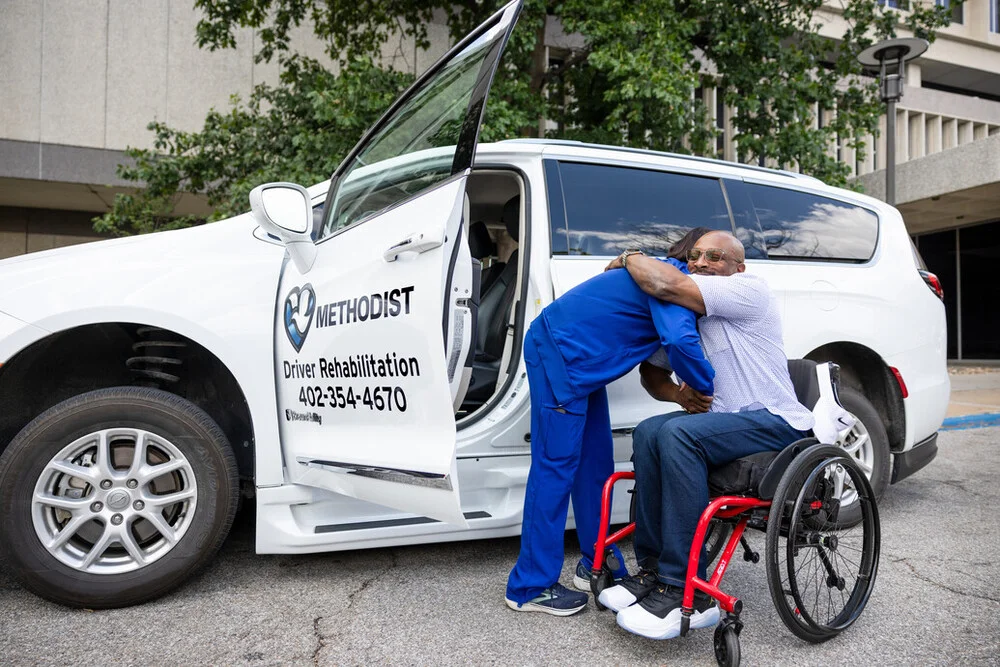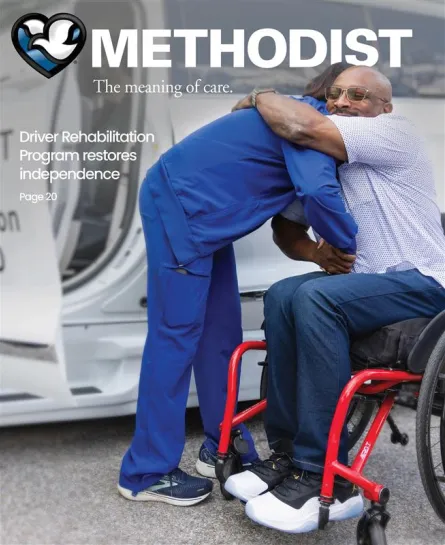





Today's Medicine
Methodist Hospital Driver Rehabilitation Program restores man's 'confidence, independence and freedom'
Published: Dec. 12, 2024Occupational therapist Kelina Moore, OTD, OTR/L, CDRS, will never forget the day she met Brian Anderson.
Moore, a certified driver rehabilitation specialist with the Methodist Hospital Driver Rehabilitation Program, provides services to clients with a range of abilities and challenges.
There are new drivers who need training beyond traditional driver education. There are more experienced drivers who are facing the effects of aging, had a medical event or simply want assurance that they’re safe to be behind the wheel. And there are some like Anderson – recovering from a spinal cord injury and looking for a path to drive again with the use of adaptive equipment.
“When I first met Brian, he was very positive,” Moore said. “He told me his situation and how he came to be in a wheelchair. But he only said it once and then never talked about it again. He was very determined to not look at the past and just move forward.”
The freedom of driving

For Anderson, 51, driving was a way of life. Whether he was working as a taxi driver or truck driver, or simply getting his family to activities, he was always driving.
“Survival for my family depended on it,” said Anderson, who began driving at age 14. “It provides a freedom, even just to take a long drive to clear your mind after a long day.”
But in an instant in 2020, his independence and livelihood were taken away.
While hauling freight from Missouri to Omaha in a 26-foot truck, he experienced a transient ischemic attack (TIA), a temporary blockage of blood flow to the brain that’s sometimes called a ministroke. Anderson went off the road and down an embankment, severely injuring his lower spine and becoming temporarily paralyzed from his waist down.
He was hospitalized for two weeks in Missouri and had extensive surgery to address his injuries. He then spent six weeks at Madonna Rehabilitation Hospital in Lincoln.
After returning to Omaha, he connected with a physical therapist for virtual appointments. On his own time, he paired his therapist’s exercises with his own, determined to strengthen his body so he could eventually stop using a wheelchair and return to work.
“To settle for being in the chair – I just couldn’t do that,” he said. “I had the mindset to push forward. I wanted to be back out there.”
By spring 2023, Anderson was using a walker around the house. Around that time, he started thinking about driving again.
“I felt mentally ready for it,” he said. “I was fed up with sitting around. People love you, and they don’t mind helping. But at some point, it gets old, and it becomes an inconvenience on their time. Even calling an Uber isn’t always the most practical thing to do.”
He mentioned his desire to drive to his Methodist Physicians Clinic primary care provider, Joseph Dumba, MD, who referred him to Moore and the Driver Rehabilitation Program.

‘An advocate for you’
Methodist’s Driver Rehabilitation Program therapists are experienced in working with drivers who have experienced:
- ADD/ADHD
- Aging
- Anxiety
- Arthritis
- Cardiovascular disease
- Cognitive impairment
- Developmental disorders
- Limb amputation
- Other physical or orthopedic impairment
- Stroke or other neurological conditions
- Vision impairment
“I think it's important to know that our driving program isn’t just for older drivers, drivers who need adaptive equipment and brand new drivers,” Moore said. “It can be for somebody who just wants a safety check. They come in and say, ‘I don't know if I'm safe to drive. I need to be evaluated so I can give peace of mind to my family, my doctor, whoever, or peace of mind just to myself.”
Clients in the program begin with a clinical evaluation to determine their physical, cognitive, perceptual and visual abilities. When possible, a behind-the-wheel evaluation follows, and adaptive equipment is available to aid a driver.
“I'm not going to be sitting in the passenger seat with a clipboard making checkboxes,” Moore said. “My job is to be an advocate for you, for your safety.”
Her recommendations to each client are tailored to their situation, but they generally fall into three classifications: A client is safe to drive, they’re no longer safe to drive or they need further training and, sometimes, adaptive equipment to resume driving safely.
“For many clients, this is a place where they can get one-on-one training with somebody who is in a vehicle that has an adaptive brake and accelerator on the passenger side, and it helps build their confidence,” she said. “It can also help them learn, if needed, adaptive equipment to help them regain that independence.”

‘On the go ever since’
Based on Anderson’s situation, Moore immediately knew that he would need hand controls to operate a vehicle again. After his evaluation, which included time on a driving simulator in the clinic, she took him to an empty parking lot and let him drive using three different styles of hand controls. He ultimately felt most comfortable with a setup that allowed him to control the gas and break by rocking a lever with his right hand while using the steering wheel with his left.
“It was easy to adapt to,” Anderson said. “It was a lot easier than I expected. It’s literally the touch of your finger. I used my right index finger to stop and drive a vehicle.”
He added: “It’s a matter of hand-eye coordination and pressure. Being an experienced driver, it made it really easy to adapt and nail this program.”
Over the next few appointments, Moore let Anderson try more challenging scenarios.
“We spent a lot of time in moderate traffic,” she said. “So four-lane roads, getting to multiple turn lanes, changing lanes, interstate driving – because that’s something he wanted to be able to get back to so he could travel, get to and from work, and see his family members. Each time he drove, he would say how important it was for him to get back to driving and how much more independence driving gave him, which is very rewarding as a therapist to hear.”
After four appointments with Moore – three behind the wheel of a vehicle – Anderson was ready to drive on his own again, and Moore wrote him a prescription for adaptive equipment. Earlier this year, he bought his own vehicle, had the equipment installed and passed a driving test to get his license.
“It was like new life for someone like me who sat around for three years,” he said. “I’ve been on the go ever since, literally.”
Since then, Anderson has moved to Arizona, but he still drives back to Nebraska to visit family and friends. Next up: more travel, finding a driving job that suits him and being able to walk with a cane.
Thanks to the Driver Rehabilitation Program and his will to succeed, he’s closer than ever to achieving those goals.
“This program has been a blessing,” he said. “It’s made a huge difference in how I see things moving forward. Even with the lack of mobility I still have, I’ve regained enough of my abilities to have the confidence, independence and freedom that I had prior to the accident.”
Photos by Daniel Johnson. Video by Nick Bohan.
More Resources
- Read more from the fall/winter 2024 issue of The Meaning of Care Magazine.
- Read more inspiring stories about Methodist patients and providers.


